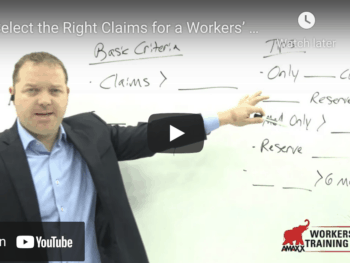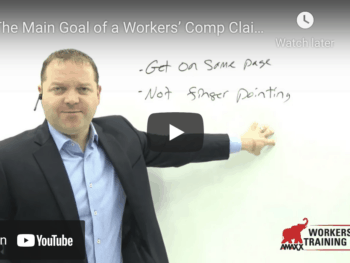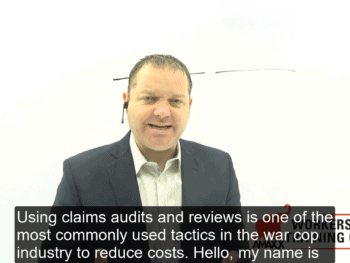This post is one in a 3-part series:
Click Link to Access Free PDF Download
“Workers’ Comp Claims Review Checklist: 9 Must-Have, Serious-Impact Elements”
Claims audits and reviews are one of the most commonly used tactics in workers’ compensation to reduce costs. Hello, my name is Michael Stack. I’m the CEO of Amaxx and I’m due to the real short three part series. How to make the most out of this time invested, we’re doing these audits and reviews anyway, you’d likely have one coming up. So how do we make that time valuable? How do we make that time efficient and how do we get the most out of it? And the first part of the series, I talked about the mindset going in, avoiding the blame game and using it as an opportunity to come together as a team and identify what can be improved and what’s going well. And how do you work more effectively to achieve a common goal in this piece, in this part of this series, I want to talk about claims to select which claims are you actually auditing?
Audit Open Claims
So here’s a little tip here as we go into this, and I’ve got a number of different kinds of tips here. The thing you want to do is audit open claims. So audit open claims, there is some value, or there could be some value in potentially auditing closed claims, but most of the value, unless there’s a specific reason that you’re auditing closed claims, you should be looking at only your open claims. So only your open claims is where you should be focusing. Okay. So we’ve established that you’re looking at your open claims. Now let’s say you’re a large organization and you have, you know, 100, 200, 300, 500 or plus open claims. You’re not going to audit every one of those. You want to get a good sample of which claims the audits. That’s what I want to talk about here. First thing that we’re gonna use is an old actuarial term called the rule of sevens to the rule of sevens.
Rule of 7’s
So let’s say you had your loss run here and you’ve got, you know, 60 pages or 50 pages or however many pages are in your loss. When you’ve got a bunch of open claims. What you’re going to do is you’re just going to pull out a highlighter and you’re going to go through and you’re just going to highlight every seven claims. So you got three, six, seven, you’re going to audit down one, three, six, seven. You’re going to audit that one, three, six, seven. You’re going to audit that one. And then you’ve got, you know, that just kind of keeps going. And then each one you pick the seventh one, and then you just highlight it going down your loss run, you’re picking each seventh one and running them with a highlighter. And that’s going to give you a really good sampling of claims. If you don’t have that many open claims, you know, say you have five or 10 or 25 claims or 30 claims, you know, a reasonable number of claims that are open.
Of course you audit every one of those because it’s a reasonable number and it’s a number that you can get through. So that’s a really good kind of start as far as picking a random sample. If you have a large number, of course you have a smaller number. Do every one of them next piece is any outlier claims. So you’re going through this loss run. I’m going to give you a couple tips here on identifying outlier claims that you want to make sure do get into your sample into your random sample. So here’s a few tips claims with large reserves. So claims with large reserves, you know, you’re going through your highlight and like, Oh, this one’s got a really big reserve. Let’s make sure we put that one in there and you run your highlighter through there and you make sure that it gets to your sample. Any medical only claims that are open six months or greater. So time open medical claims, medical only claims six months or greater.
Reserve Authority
Say your reserve authority or the adjuster’s reserve authority is 25,000 or maybe it’s 15,000 or maybe it’s 50,000, whatever it is for that particular adjuster. And the reserve is, you know, 24, 900 or in this case 14, 900 or in this case 49, 900, anything that’s close to the reserve authority. So you, in order to get a larger reserve, you have to ask someone’s permission. And so the adjuster in that case is maybe just being lazy. Maybe he doesn’t want to go through it and maybe isn’t that confident in it, whatever the reason is they put it right up to the reserve authority, but not higher. There’s something there. There’s a reason that it’s there. That’s a possibly a placeholder for that adjuster. So that’s the one you’re going to want to take a look at and just dig under the hood a little bit more and figure out actually what’s going on. Another piece here is just large medical only claims. So large medical only claims. If you have a medical only claim, that’s a significant sum. You know, whether it’s 50,000 or 75,000 or, you know, depending on the size of the organization, maybe 30,000 is a large medical only claim, whatever that means for you, a large medical only claim, make sure that you’re going through your list. You’re like, okay, that’s one for us to take a look at. And then the last piece here
Use Common Sense
What to do in this is you’re trying to figure out anything that needs to be looked at more, any potentially problem claims, any, any claims that might be outlier type claims, leverage common sense if you’re going through and just something doesn’t look like, look right. The notes don’t look right. As far as what the adjuster’s written down, you’re based on your experience. Do you know this type of injury that that’s, that the claim is that has, you know, those can be problematic and you’ve seen a lot of problematic claims like that in your career. So leverage common sense as far as picking out those claims that, you know, add to your list. As I said, using claims audits and reviews are one of the most commonly used tactics. We want to make sure we’re getting value from these. We want to make sure the time invested in these is effective, that we were getting a return on that investment of time and putting it towards an effective and improved work comp system. And again, my name is Michael Stack. I’m the CEO of Amaxx. Remember your work today in workers’ comp can have a dramatic impact on your company’s bottom line, but it will have a dramatic impact on someone’s life.
So be great.
 Author Michael Stack, CEO Amaxx LLC. He is an expert in workers’ compensation cost containment systems and helps employers reduce their workers’ comp costs by 20% to 50%. He works as a consultant to large and mid-market clients, is a co-author of Your Ultimate Guide To Mastering Workers Comp Costs, a comprehensive step-by-step manual of cost containment strategies based on hands-on field experience, and is the founder & lead trainer of Amaxx Workers’ Comp Training Center, which offers the Certified Master of Workers’ Compensation national designation.
Author Michael Stack, CEO Amaxx LLC. He is an expert in workers’ compensation cost containment systems and helps employers reduce their workers’ comp costs by 20% to 50%. He works as a consultant to large and mid-market clients, is a co-author of Your Ultimate Guide To Mastering Workers Comp Costs, a comprehensive step-by-step manual of cost containment strategies based on hands-on field experience, and is the founder & lead trainer of Amaxx Workers’ Comp Training Center, which offers the Certified Master of Workers’ Compensation national designation.
Contact: mstack@reduceyourworkerscomp.com.
Workers’ Comp Roundup Blog: https://blog.reduceyourworkerscomp.com/
©2021 Amaxx LLC. All rights reserved under International Copyright Law.
Do not use this information without independent verification. All state laws vary. You should consult with your insurance broker, attorney, or qualified professional.

















